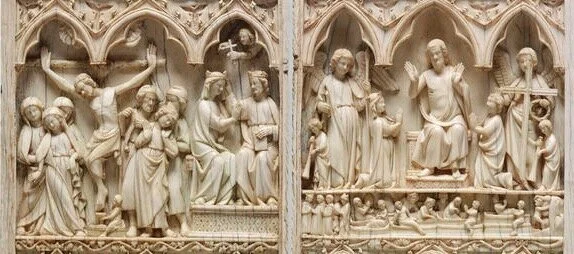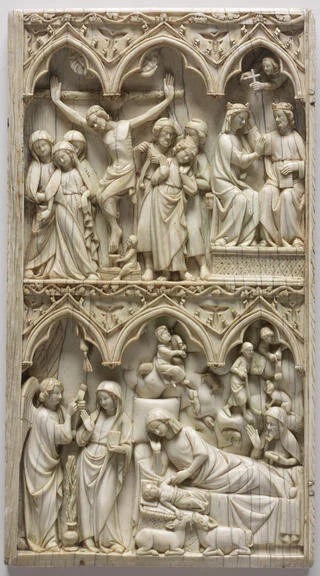One of my favorite works of art at the RISD Museum is an object which might otherwise go unnoticed. It isn’t very large or impactful on first glance but, at about the size of a small book, it is tucked away in a corner under glass. An ivory diptych dating to around 1300, this piece depicts in exquisite detail scenes from the shared lives of Jesus Christ and his mother Mary. An exceedingly well crafted artwork, it is also one of arresting beauty. It is difficult to understand the views and opinions of those who lived hundreds of years before us, but occasionally art can make it possible. In the case of ivories like this one, we can step back in time and begin to enter the medieval mind and to experience the religious devotion that has largely come to define this period in European history.
Unknown Artist, French, Île de France, Diptych with scenes of the Nativity, the Crucifixion, and the Last Judgement, Ivory with traces of polychromy, ca. 1275–1325, each panel is 9.5” x 5.25”
Small ivory devotional objects in the form of miniature would-be altarpieces were extremely popular in the medieval Christian world and were produced en masse in workshops, the finest of which were located in France. These pieces, typically in diptych or triptych form, could be set up on a table within a domestic setting and then folded shut for travel. The life of the aristocratic class who could afford such an indulgence was a mobile one. Sculptural images such as this were the three dimensional equivalent of books of hours and psalters. A plethora of religious tools engaged lay Christians in a kind of prayer that matched their clerical counterparts.
Ivories would have been richly painted with polychromy, and now a few examples survive of similar works which retain their coloring. Because these objects were so purposefully tactile and because much of medieval devotion centered on the touching, caressing, and even kissing of iconic images, most extant ivories are largely denuded of color. RISD’s retains some traces, which the careful observer can find in the fine crevices of the ivory’s detailed carving.
In a contemporary world so impacted by the new norms of social distancing and in which church services for Easter weekend have largely been cancelled or moved online, the type of individual prayer common in the Middle Ages takes on a new resonance. Objects like this facilitated and were integral to the interior lives of the faithful in a time when public displays of religion were counterbalanced by rich private prayer lives in a complicated puzzle of devotion.
In RISD’s ivory, the viewer witnesses the intertwined stories of Mary and Christ, starting in the lower left register with an episode called The Annunciation in which the Angel Gabriel announces to Mary that she will bear God’s child. Mary holds a prayer book, signifying her unique faithfulness. Between her and the angelic messenger stands a vase holding a lily, a symbol of her purity as a spotless and holy virgin. In the same lower register, we can follow the continuous narrative. The figure of Mary appears again, this time laying on a cot next to the swaddled Christ child at The Nativity. She looks down adoringly at the child while above her within a cloud shepherds are told of the good news by an angel faraway. The visual constructions used in ivories followed rubrics which created images that were easily readable and readily duplicated. The result is something like a cross between a comic strip and a storyboard.
Unknown Artist, French, Île de France, Diptych with scenes of the Nativity, the Crucifixion, and the Last Judgement, Ivory with traces of polychromy, ca. 1275–1325, left panel, 9.5” x 5.25”
Across the central vertical hinge of the diptych the narrative continues. In the entire bottom right register, The Adoration of The Magi is depicted. At the left, a groom handles three horses entering a city gate indicating the far journey of the travelers. The three kings occupy a central space within this frame, each taking on a unique stance and presenting their individual gifts to Christ who stands precarious but confident on his mother’s knee. On the rear of the panel three oak leaves likely indicate the kingly lineage of Christ within the House of David. All medieval images, from great public works down to small personal ivories, are filled with a thickly layered language full of multivalent signs and symbols. For a medieval viewer, details that may be lost on us would have been common parlance. The three gothic arches which hover over each seen are a more clear symbol, underscoring the trinitarian nature of Christian belief.
Unknown Artist, French, Île de France, Diptych with scenes of the Nativity, the Crucifixion, and the Last Judgement, Ivory with traces of polychromy, ca. 1275–1325, right panel, 9.5” x 5.25”
In the upper registers of the panels, Christ’s crucifixion appears at the far left, followed by the crowning of his mother as Queen of Heaven. After the vertical hinge the story is consummated with The Last Judgement. Christ sits centrally, bookended by angelic hosts holding the instruments of his martyrdom - another common conceit in medieval art. Mary kneels at Christ’s righthand, signaling her preeminent status within a Christian canon which numbers saintly individuals in the thousands. Below these heavenly people, in a second register demarcating the earthly realm, minute figures awake in their tombs and raise from the dead in a moment of prophetic foreshadowing. Such is the everlasting life promised in Christian scripture.
RISD’s ivory is a small artwork so full of detail that it can be looked at again and again and enjoyed for hours. It invites contemplation even from an unbeliever. Contemplation of design, of form, of composition, and of narrative. Not to mention of the historical sociological implications such works have.
There tends to be a reading of the Middle Ages, fed by the common misnomer “the dark ages”, as a time of religious terror and general ignorance. In reality the picture is much more complicated. While there was enormous inequality and limited access to education, most Christian adherents during this period had a faith that was both profound and uncynical. The evidence that comes down to us paints a picture of sincere religious devotion borne out in public and private displays of faith that took place across a calendar packed with holy days both high and low. There was a frank belief in theological certainty and an acceptance of both heavenly salvation and hellish damnation. Christianity was also, though, a social practice set within a milieu shared with university foundations which gave us most of the eminent European institutions whose names are now taken as shorthand for learnedness.
The works of art which survive from this period are equally complex and ivories tell just one part of that story. From the guilds of Parisian sculptors that produced them, to the courtly figures who prayed over them, many members of a stratified society laid hands on these objects. And later, similar works were coveted by a spectrum of collectors who wanted to use them as emblems of their own sense of history; they were bought and sold by robber barons in the nineteenth century and looted by Nazis in the twentieth. Today, regulations around endangered species make the purchase of works that include ivory incredibly problematic if not entirely illegal.
The ivories that are available for public appreciation exist mostly under glass in the corners of quiet medieval galleries in museums. But they still hold a kind of magnetic sway. For a viewer in the twenty-first century, that appeal is much more commonly about craft and construction than about religion and devotion but it still exists. These are objects designed to pull one in close, to be educative and inspiring.
The same ivory that we observe now was handled seven centuries ago by a devotee. The same rivulets of tiny botanical borders that we can lingeringly appreciate in a museum were also known intimately by someone of another time entirely in the drafty bedchamber of a great house in Northern Europe. These are two worlds connected not necessarily by the same faith or by the same societal structure, but bound instead by an object. This object.
Therefore an ivory like this can tell us much not only about Paris in 1300, but about our time and place. It can show us that the interior life and indeed the solitary life are not always to be avoided but can instead be fulfillingly embraced. And such lives can also bring a recognition and appreciation of a kind of beauty - one which is both transcendent and even, occasionally, sublime.



